Rosewood History
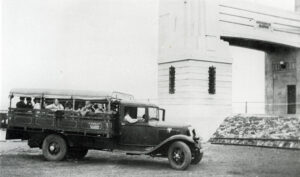
Students from Tallegalla State School on a trip to see the new Hornibrook Highway Bridge, Redcliffe, ca.1935
SCHOOLS
In 1929 an article was written for the occasion of the Tallegalla School jubilee. The talented writer’s expression could be applied to any school established in those early days.
In the year of grace, 1879, the pioneering of Tallegalla saw in the opening of its first school a worthy result of personal sacrifices, which bestowed upon those who have come after, a heritage of no mean value. They were wrestling with Nature and wresting cultivated holdings from inhospitable scrub lands. Their work was long and tedious, their hours of leisure strictly limited, and their facilities for social intercourse meagre-yet they had sufficient community spirit to build for the future, and to ensure for their progeny what educational facilities they could afford. They dreamed a dream; but their actions made possible the realisation of an ideal. We are too prone to forget the magnificent courage and self-denial that are part of the pioneering spirit. A round of work, with no limitation to hours and the probability of a poor return financially for the energy expended, a life more or less divorced from ordinary comforts; disappointments, uncertainty, labour, and love and instructing their young as best they could, yet sufficiently citizens of the world to make a brighter future for their children than they could presently enjoy; such was their lot.
In these days when the modern child accepts free education as a matter of course, it is well that these “back to school” jubilees should be continued. The children of to-day should be taught the romance of education in their immediate neighbourhood, the value of the tradition that the pioneers have handed down to them, the expense of spirit that has gone to their benefit, and their duties as recipients of educational privileges. Our children should have a sense of debt to their forbears, whose example should instil a lesson of determination, courage, and the value of building for the future in their fertile young minds. The influence, of every school is widely felt in every district, and loyalty to a school is a sure precursor of loyalty to civic duty and State enterprise.
DISTRICT SCHOOLS
ROSEWOOD (17 School Street, Rosewood)
The Rosewood Gate Provisional School, subsidised by the Government and parents, was opened on 17th October, 1870 in the old Rising Sun Hotel building on the main Toowoomba-road. There were 16 boys and 14 girls on the roll. New immigrant, Walter Hore, was appointed to the Department of Public Instruction. His first posting was as the first Provisional School teacher at Rosewood Gate.
The Rosewood Gate Mixed Primary School opened on 1st February, 1875 and was situated on land on the other side of the old Toowoomba road, opposite the old Inn. Mr Dan Desbois was appointed as the first school master.
The first pupils to enrol were: Dan Desbois, Gerald Desbois, James Mulholland, John Matthews, Albert Boughen, Arthur Boughen, James Matthews, Frederick Hannant, Richard Mason, Michael Farrell, John Vance, William Vance, Thomas Walker, George Walker, Samuel Hammill, John Hammill, Richard Scanlan, Francis Pedrazzini, Daniel Dale, Lawrence Ryan, Patrick Ryan, Robert Hallam, Julia Ann Moran, Alice Desbois, Helen Smith, Margaret Black, Rebecca Mulholland, Catherine Farrell, Mary Ann Farrell, Margaret Matthew, Margaret Ellison, Sarah Jane Hammill, Elizabeth Dale and Bridget Ryan.
The name of the school changed to Rosewood in 1887.
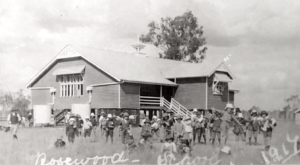
A new school was built in 1905 by Charles Ridsdale, local contractor. It faced the side-road (School Street).
The Queensland Times reported on 18th November 1905, page :- Another very old landmark, the old Rosewood State School has disappeared. Part of the material is to be used in making additions to the teacher’s residence, a very much needed improvement, the contractor being Mr. C. Ridsdale, who was also the successful tenderer for the new school. A meeting of the committee was held, last evening, and it was decided to try to have a verandah added to the school residence.
The building will be erected on stumps 7ft from the ground, and, the dimensions will be 66ft by 26ft with 9ft verandahs at back and front; teacher’s room, 16ft by 13ft. The walls are to be 12ft 6in high; roof of corrugated iron. It is to be one long room, which will be cove-ceiled: Ample ventilation will be secured by means of 51 pairs of windows and also by ventilators, the latter being of the latest kind, of special design, bell-shape, with escape pipe. The space under the building is to be asphalted and the lavatory stands placed there. The hat-rooms will be fixed with an ample supply of pegs. The furniture and fittings throughout will be of the latest designs, and, when finished, the whole will be an up-to-date seminary, and an ornament to the township.
Provisional School Teacher-Walter Alexander HORE
Dan DESBOIS-First Master at Rosewood Gate Mixed Primary School
Rosewood State School 1875 – 1975. I. S. Kearsley and J. A. Meehan – Picture Ipswich
————————————————————————————
ROSEWOOD STATE HIGH SCHOOL (46 Lanefield Road, Rosewood)
In 1962 a a secondary department was added within the primary school grounds. Students used to cross the overbridge at the Railway Station to attend some classes in the building that had previously been occupied by the Slipper Factory. A separate state high school was established and opened on 29th January 1980. Noel Christie was the first Principal.
Stalwart of the Rosewood community, Mr. Clyde Nicoll, worked at the school from 1986 until he retired in 1999. He was appointed Principal in 1987 and continued in that position for for twelve years.
————————————————————————————
ST BRIGIDS PRIMARY SCHOOL (Railway St, Rosewood)
St Brigid’s Catholic Primary School was established on by the Sisters of Mercy under the leadership of Sister Mary Stephen. Archbishop of Brisbane, Dr. James Duhig, visited Rosewood in September 1921 for the blessing of the foundation stones of the new convent school. It was opened and blessed at 3p.m. on Sunday 29th January 1922, by Archbishop Duhig. A McKeen car was organised for those wishing to attend. It was scheduled to leave Ipswich at 2 p.m. and Grandchester at 2.45 p.m and left Rosewood at 5.30 pm on its return journey.
The school had an enrolment of 125 students in its first year of opening. The Sisters of Mercy left the school in 2011. The Queensland Heritage Register – Rosewood

————————————————————————————
SEVEN MILE CREEK / EBENEZER
It is recorded that the Seven Mile Creek State School opened on 2nd November 1868. However, George Jacobs (teacher) opened a private school in October 1867 in a slab building adjacent to an old butcher’s shop, which was used as a playshed. He kept it open under great difficulties, asking several times for the Board to grant him a stipend to help support himself and his family. Mr. George Jacobs was appointed the first teacher and he occupied the position for 17 years. The school was started with 48 pupils.
On February 10th, 1873, the school was moved to a newly erected building on a piece of land donated by Mr. John Armstrong and the name was changed to Ebenezer State School. The school closed approx. 1st December 1957. It was located at 354-356 Ebenezer Road (opposite the junction with Turnbull Road).
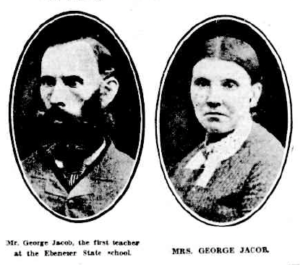
School Inspector’s Report 1876 – SEVEN MILE CREEK
Inspected 14th July.
First inspection: Enrolled, 52 ; 27 boys and 25 girls.
Present, 31; 18 boys and 13 girls.
Second inspection: Enrolled, 42; 21 boys and 21 girls.
Present, 31; 16 boys and 16 girls.
The school-house is in good condition. There is no teacher’s residence, and the teacher lives a mile off. White ant is already at work in the closets. The ground is not cleared or fenced, but fencing stuff is nearly all prepared. The teaching is of a patient and persevering character, quite intelligent but not very impressive. Very considerable improvement was noticed in the general conduct of the school at the second inspection. The proficiency was decidedly fair, and the attainments uniform and regular. The tone of the children under examination was quite pleasant.

[Queensland Times, Tuesday 6 December 1938, page 5]
ROSEWOOD DISTRICT EBENEZER. Saturday. A meeting of residents was held in the school on Wednesday night to finalise arrangements for the 70th anniversary celebrations to take place next Saturday. On the same day the new school building will be opened. The celebrations will take the form of a basket picnic, and arrangements have been made for the conducting of a soft drink and ice cream stall. At 11.15 the old scholars will be officially welcomed, and later in the day Mr. E. B. Maher will open the new building. Special invitations have been sent to all scholars who attended the school in 1868, where it has been possible to trace them: also to past teachers.
Pictured: The opening of the Ebenezer school in 1938.
————————————————————————————
ALFRED/CALVERT (29-35 Newcastle Street)
Alfred State School opened on 11th March 1872, with Mr George Vowles in charge. It closed on 31st December 1909. The renamed “Calvert State School” opened 1st January 1910.
In 1922 it was the second oldest school in Queensland and in 1938 it was the oldest.
In January 1930, a new school was built and repairs were made to the school residence. T. Rundell (Brisbane) carried out the work for £122. It closed 31st December 1972.
The photos are not clear images but were the only ones I could find to date. The first school and the new school.
School Inspector’s Report 1876 ALFRED
Inspected 18th May, and 2nd and 3rd December.
First inspection : Enrolled, 80; 40 boys and 40 girls.
Present, 58; 26 boys and 27 girls
Second inspection : Enrolled, 79; 41 boys and 38 girls.
Present, 37; 20 boys and 17 girls.
 The teacher’s residence suffers from white ants. The water supply is not satisfactory. The grounds are fenced, but the posts are slack and the gates badly hung. Several minor matters about the premises require attention. The school is well furnished internally. Order and discipline are good. The school is conducted with fair efficiency, and progressed between inspections.
The teacher’s residence suffers from white ants. The water supply is not satisfactory. The grounds are fenced, but the posts are slack and the gates badly hung. Several minor matters about the premises require attention. The school is well furnished internally. Order and discipline are good. The school is conducted with fair efficiency, and progressed between inspections.
1938 – The structure is erected on blocks about 8ft. high, and consists of one room with a verandah on both the western and eastern sides. The room measures about 21ft. by 18ft., and both verandahs extend the full length on each side. Steps lead up to the middle of each verandah, and at one end a hat-rack had been made. Thus the school has a similar appearance when viewed from either the western or eastern sides. In the schoolroom two new blackboards have been fitted, and eight desks and forms placed in position. The room is very well lighted by a series of windows at both the southern and northern ends. Provision has been made for an attendance of about 40 children. The walls and floor are of hardwood, and the building has been lined with pine. The outside blocks form the sup-ports for three walls which enclose the area under the school to form an additional room. Taps and a wash stand have been placed in position in one corner. The whole building is slightly smaller than the old building.
————————————————————————————
TALLEGALLA (2-6 Tallegalla -Two Tree Hill Road now Rosewood Minden Road, Tallegalla)
The Queensland Heritage Register – Rosewood
A public tea meeting was held on Good Friday afternoon, 11th April 1879, at three o’clock in the new school house (Tallegalla) in celebration of the opening. The school was actually opened on 10th June 1879. 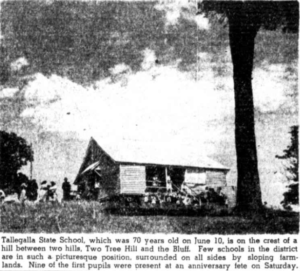 The building was designed by colonial architect, F. D. G. Stanley. The school closed 18th December 1992, due to low student numbers. It was added to the Queensland Heritage Register on 2nd February 1998.
The building was designed by colonial architect, F. D. G. Stanley. The school closed 18th December 1992, due to low student numbers. It was added to the Queensland Heritage Register on 2nd February 1998.
[Queenslander, Saturday 6th March 1897, page 523]
Tallegalla State School.
The school occupies the summit of a high hill in the Rosewood Scrub, about four miles from the Rosewood Railway Station, and commands one of the prettiest views in Southern Queensland. When the present head teacher (Mr. J. W. Watkins) took charge of the school, (between seven and eight years ago, the grounds were a desolate waste, overrun with sida retusa and other weeds. He at once set to work to create a change, and with the hearty co-operation of the school committee, and especially of Mr. Alfred Embrey, the chairman, he has gradually transformed the place into the lovely spot shown in our pictures. In the manual work connected with this transformation the elder boys attending the school have rendered willing aid, and the teacher’s efforts to beautify the grounds have been readily seconded by the department, who have seen that the buildings, fences, &c, were kept neat and well painted. Instead of the ordinary playshed, there has been erected an octagonal summer-house, covered with bushes, which is quite in keeping with the surroundings of the school. These views serve to accentuate the remarks made by Mr. J. G. Anderson, Under Secretary to the Department of Public Instruction, on the subject of making bush schools attractive.
[Brisbane Courier (Qld. : 1864 – 1933), Wednesday 19 June 1929, page 20]
SCHOOL JUBILEE. TALLEGALLA CELEBRATES. REUNION OF FORMER TEACHERS AND SCHOLARS.
ROSEWOOD, June l8. -The Tallegalla State School, situated about five miles from Rosewood, celebrated its jubilee on Saturday amidst great enthusiasm. The history of the establishment of the school is practically the history of the district. The school was opened on June 10, 1879, the land, about three acres, being the gift of Mr. William Arndt. The original school still stands, in excellent order, additions and improvements having been made from time to time. The district had been named Tallegalla some time previously by Mr. John Dart, a resident who was in charge of the receiving postal office. The word is aboriginal, meaning scrub turkey, and these birds abounded in the neighbourhood until comparatively recent years.
ANSWERING THE ROLL CALL.
Mr. Henry Vivian Dunbar was the first teacher. He was followed by Messrs. John Marquis (1880 to 1881), Thomas Ernest Phillips (1881 to 1882), Mrs. Jemima Phillips (1882 to 1884), Arthur Lambert Spencer (1885 to 1889), John W. Watkins (1889 to 1900), Charles George Franklin (temporary 1900 to 1901), John W. Watkins (1901 to 1904), Frank J. W. Eichstadt (1904 to 1911). Daniel Courtney (1911 to 1926), Albert W. L. Russell (1926 to 1927), and Hugh Edmund Gilbett Grayson (from 1927).
Of these the first four mentioned are deceased. Messrs. J. W. Watkins (now of Manly State School), F. J. W. Eichstadt (retired, Rosewood), and D. Courtney (Eagle Junction State School), with the present head teacher, were present at the celebrations. Mr. Russell is in the Rockhampton district.
On the first day of school nine children were enrolled, but the numbers increased gradually each day until at the end of the year there were 39. Of these old scholars, 11 were present on Saturday last. A very large proportion of the others have joined the great majority; others are in various parts of Queensland and New Zealand.
Those who responded to the roll call were Mr. William Arndt (Mt. Sylvia), Mr. Hermann Ardnt (Tallegalla), Mrs. Beavis (Elizabeth Ponting), of Roma, Mr. John Berlin (Kunkala), Mr. T. A. Austin (Tallegalla), Mrs. Brown (Albertina Iszlaub), Booval, Miss Amelia Muller (Tallegalla), Mr. William Ruhl (Rosewood), Mr. Moses Freeman (Tallegalla), Mr. James Freeman (Tallegalla), and Mrs. Brooks (Mary Ann Austin), of Blackbutt. When the old scholars had fallen into line at the call of the school bell, a welcome was extended to them by May Gerber, on behalf of the present scholars, by Mr. H. Gerber (chairman of the School Committee), and by Mr. Grayson (head teacher).
JUBILEE CAKE CUT.
Extensive preparations had been made by the committee and residents for the celebrations. A large marquee had been erected, in which tables were placed. On the jubilarians’ table was a fine three-tiered cake, made at the Marburg Rural School, and iced by Miss Gerber, daughter of the chairman. This cake was cut by one of the old “girls,” Mrs. Brooks, of Blackbutt (Mary A. Austin). Mr. H. Gerber, chairman of the committee, presided. Mr. H. Grayson proposed the toast of the jubilee scholars. This was acknowledged by Messrs. Moses Freeman (Tallegalla), William Arndt (Mt. Sylvia), and John Berlin. The toast of the “Old Teachers” was proposed by Mr. Henry Ballin, Major J. W. Watkins, of Manly, responding. Mr. E. B. Maher, M.L.A., proposed “The Education Department,” Mr. Watkins responding on behalf of the department.
The original committee, as far as can be ascertained, were Messrs. J. Ponting (chairman), W. H. Austin, C. Freeman, John Dart, Iszlaub, W. Arndt. All those old pioneers have passed away. The present committee are Messrs. H. Gerber (chairman), A. E. Freeman (secretary), H. Embrey, sen. (treasurer), M. Goss, Henry Ballin. W. Freeman, and L. A. Niebling.
————————————————————————————
WALLOON (528 Karrabin-Rosewood Road, Walloon)
Picture Ipswich gives this information. The non-vested school at Walloon was opened in 1865 under the name “Guilfoyles Creek”. There were 41 pupils enrolled, most of them being children of railway workers. The private school was run by the Catholic Church but was supported by the Queensland Government.
Inspector’s Report
WALLOON SCRUB SCHOOL
(Inspected 24th November, 1876 )
On roll-boys 41, girls 35, total 76; present- boys 38, girls 30, total 68.
A portion of the ground has been cleared and well fenced, and the teacher has already promised little flower gardens; the buildings are new, sufficiently suitable for present requirements, and in good condition throughout. The supply of furniture, apparatus, and materials is nearly sufficient.The attendance is large and regular; the results are fair; order and discipline are both good; the general condition of the school is satisfactory.
In August 1873, 10 acres and 26 perches at Walloon was reserved for a “national school”. Tenders were invited by the Works Department in October 1876 for the erection of the school. It was officially opened 9th July 1877 with 87 scholars under the charge of Mr. A. B. Kemp. The Committee in 1878 was Frederick William Linning, Peter Klüfel, Charles Voss, Laurence Krebs, Henry Tronc. Augustus Krüger was added in 1879.
The old school building was condemned by the Works Department in 1935. Work started on building a new school in August and was finished in December. –The State school-house is going up, and, as far as bush to the carpenters are concerned, everything is first-rate; but the Education Department should employ a more inventive architect; for it is too bad to have our children stowed away all day, in a Queensland climate in the “stew-pot,” now going up. No building is complete in our climate without a deep verandah all around.
A new school was built and opened by Mr F. A. Cooper on Saturday, 22nd February 1936. It had two spacious school rooms, wide, airy verandahs, and a shaded, 8ft. high ground floor, which was to be concreted in the near future. Plenty of sunlight and ventilation were features of the whole construction, and the roof of the verandah and rooms was ceiled throughout. Mr. Cowie was appointed as the teacher, with an assistant teacher, Miss J. Price.
There was a strong desire to keep the 60 year old school building at the time. It was suggested that it be moved to the corner of the grounds and used as a dancehall, as it had previously been the scene of many charitable functions.
————————————————————————————
MARBURG (Louisa Street, Marburg)
Frederick State School opened on 18th March 1879 in Edmond Street. The town was known as Frederich at that time after one of the district’s leading pioneers, Johann Ludwig Frederich. Twenty-six pupils were enrolled on the first day, twenty-two being placed in the infant’s class. The number increased to 70 by the year’s end, fifty-six of whom were classed as infants. James Stuart was the first teacher until 30th June 1880. In 1888 the name of the town was changed to Marburg and the school’s name was changed to Marburg State School.
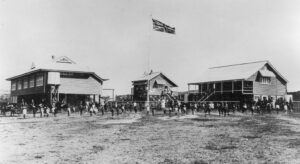
Marburg Rural School
The school commenced in buildings in the Show Grounds until 29th January 1922, by which time the original school buildings had been transferred bodily across the hill to the new site half a mile away in Louisa Street where a new sectional building had been erected. The Department of Public Instruction bought 10 acres of land from Mr A. Beutel for the site.
Mr V. E. Pascoe, head teacher of the Marburg Rural School, forwards particulars regarding the course of instruction at this newly established school. The pupils will take the ordinary State school curriculum until they have completed the work of the fourth class, when the rural course will be taken, unless the pupil wishes to qualify for a State scholarship. The training for the boys includes wood-work, tinsmithing, blacksmithing and agricultural science, and that for the girls cooking, sewing, dressmaking, fruit-preserving, jam making, laundry work and house-keeping.
In 1977, a pre-school centre was added
Photo: Marburg State School, at the original location, 1910 Marburg State Rural School, 1926
————————————————————————————
ASHWELL (35 Reinke Rd, Ashwell)
The school opened 7th November 1887, under the charge of teacher John Taylor. An acre of land was given by Walter Loveday, and Henry Morton Stevens also gave an acre from his adjoining block. George Schlecht built the school which opened with 56 pupils. Gertrude Susannah Stieler (nee Waight) cut the centenary cake at the school’s celebration. She was the oldest living ex-pupil at the time.
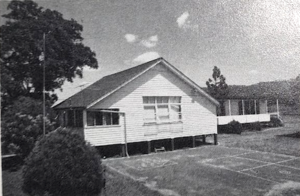 [Courier-Mail, Tuesday 7th December 1937, page 23]
[Courier-Mail, Tuesday 7th December 1937, page 23]
The golden jubilee of Ashwell State School (via Rosewood) was celebrated last Saturday. It was opened on November 7, 1887, with an enrolment of 52 pupils. Of these 11 answered the roll call last Saturday — namely, Louisa Loveday (Mrs. S. Williams, Ipswich); Harriet Loveday (Mrs. E. T. Harding, Cabanda); Catherine Burns (Mrs. J. Cannan, Mt. Walker); Mary Burns (Ipswich); Elizabeth Henderson (Mrs. J. E. Evers, Rosewood); Jane Henderson (Mrs. P. Whyte; Lanefield); Wilhelmine Hobbs (Mrs. Dickfos, Kalbar); Patrick Lenehan, Alexander Lane, Thomas Ludlow, Frederick Bassett (Gayndah). In the 50 years the school has had only four head teachers— John Taylor, 1887-1893; C. J. O’Brien, 1893-1907; William Croston, 1907 -1929; and E. J. Kelleher (the present teacher), since 1929. The three first named are dead. The Leader of the Opposition (Mr. E. B. Maher, M.L.A.), proposed “The Day we Celebrate.” A Jubilee cake was cut by the old scholars present. The present day scholars were entertained by the committee at a picnic and a sports afternoon. Souvenirs of the Jubilee were presented to Mr. E. J. Kelleher (head teacher), Mrs. Kelleher, and Miss M. Blackman (assistant) — a tobacco pouch to the first named and crystal serviette rings to the ladies. The presentations were made by Hector Coulson and Hazel Horne, two of the present scholars.
————————————————————————————
GRANDCHESTER (School Rd, Grandchester)
Grandchester Provisional School opened in November 1870 in a tent borrowed from the Queensland Government. which closed after one month in December 1870.
Grandchester State School opened on 29th January 1878. In July 1877, successful tenders to build Messrs J. Byers and Son. He had finished the Upper Tenthill school and had already been preparing the timber for the school. The build was completed in September. The first Teacher James MacDonald. Committee John Moran, John Howell, Edward Pender, Denis Dwyer, John Connolly.
GRANDCHESTER NEW SCHOOL. Under date the 7th instant, Mr. H M Stevens, M.L.A., is in receipt of information from the Under Secretary, in the Department of Public Instruction intimating that the Works Department had advised that it had been approved to proceed with carrying out, by day labour of the erection of type number 2 State School at Grandchester at an estimated cost of £340. [Queensland Times, Wednesday 13 December 1916, page 4]
GRANDCHESTER SCHOOL BURNED. A sensation was caused last evening at 7 o’clock, when the State school building waa found to be on fire The school master (Mr S. N. Alcorn), the committeemen and other willing helpers very quickly on the scene, but nothing could be done to save the burning building, or rescue any of the books or fittings, as the flames had too strong a hold. The fittings included a new sewing machine which had lately been acquired for the use of the female pupils. Last evenings fire has removed one of the oldest land marks of the town, the building having been elected some 40 years ago. The origin of the fire is a mystery as the school master states that everything was in perfect order when the school was locked up yesterday afternoon. [Brisbane Courier, Wednesday 27th September 1916, page 5]
————————————————————————————
HIDDEN VALE (779-799 Hiddenvale Road)
GRANDCHESTER April 24th – At a public meeting at Hidden Vale to take steps to secure a provisional school, Mr A J Cotton generously donated the use of a new building (now being erected) for the purpose. As is it is promised that 13 children will attend hopes are entertained that the school will be granted. [Brisbane Courier, Tuesday 25th April 1916, page 4]
Hidden Vale Provisional School opened on 10th July 1916. In 1919 The Governor in Council approved the establishment of a State school at Hidden Vale to supersede the existing provisional school at that place as from 1st September. It became Hidden Vale State School. At the 25th anniversary Mrs G. Heit made the jubilee cake. Suspended over the cake was a silver bell was presented to the mother of the oldest scholar, Mrs. Bleisner. It closed on 15th February 1943. It was at 779-799 Hiddenvale Road
Conspicuous on a on the left-hand side of the road, as fine approaches the homestead from Grandchester, is a picturesque little building landing in the centre of several acres of land bounded by lows of camphor laurels and weeping figs. It is the Hidden Vale School house. The building of the school is due to Mr. Cotton, who also gave the land on condition that when the school was established the Government bought the whole from him. It is under the most pleasing conditions that the pupils averaging about 14-of this little country school imbibe their learning under the guidance of Miss Dunne. Clean, white painted walls are round them, against which vases of bright flowers show to advantage and give pretty variety, while on most days the large sliding windows are open to the pure air, and give a view of the open vale and range of beautiful soft blue mountains. Less than a quarter of a mile from the school is the quaint and much becreepered old slab home of Mrs. Hogan, one of the oldest identities of the district. It stands in the midst of a garden filled with hardy, old fashioned flowers and vegetables. Gardening is the old lady’s hobby, albeit, she can only walk with difficulty, and, the aid of a stick, and she is ever pleased with a gift of a few plants or flowers. Visiting Granny Hogan is an established custom among her neighbours. (1925)
————————————————————————————
MT MARROW (272 Thagoona Haigslea Rd, Mount Marrow)
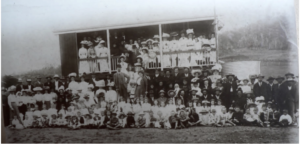
Mt Marrow Primary School was opened 4th November 1909. The celebrations took place the 27th when Mr Denis Thomas Keogh, M.L.A. declared the school open at 12 o‘clock , in the presence of a very large gathering. Messrs C. Berlin and A. M. Rea gave an acre of land each for school grounds. The school was situated about a mile and a-half from the Thagoona railway station. It was 28ft x 15ft, with two 8ft verandahs, and was lined and ceiled, and was built on piles 7ft from the ground so that there was ample room underneath for children to “engage in games”. The building was replete with all up-to-date accessories, and had seating accommodation for 50 pupils. The head teacher was Mr. J. J. Ford and about 40 children were enrolled. In the evening a social gathering was held in the school room. Music was supplied by Messrs Auld and Hahm, while Mr Dohm controlled the dancing.
When the first Arbor Day celebrations were held the next year on Saturday, 30th July, over 300 people were present. Mr Keogh was there to hoist the flag.Various trees were planted around the grounds. The head teacher and the school committee, consisting of Messrs. G. Hertweck (chairman), A. M. Rea (secretary), W. Zerner (treasurer), J. C. Holzwart, C. Berlin, T. O’Shea, and W. Klupfel, together with several ladies, did all in their power to make the gathering enjoyable. In the evening the annual “social” was held in the schoolroom. The building was crowded. A waltzing competition was won by Mr. K. Kleve (Rosewood) and Miss L. Berghauser (Ipswich). The music was supplied by Messrs. G. Hertweck, E. Bell, and W. McQuillan. Mr. T. O’Shea had charge of the dancing arrangements. An exhibition of step-dancing was given by Miss D. Lebeter.
————————————————————————————
GEHRKEVALE (4 Alpers Road, Mt Mort)
Gehrkevale Provisional School opened on 18th January 1904. On 1 January 1909, it became Gehrkevale State School. In May 1917, it was renamed Mount Mort State School. It closed temporarily between 1947 to 1949 due to low student numbers. It closed permanently on 18th September 1959.
[Queensland Times, Ipswich Herald and General Advertiser, Thursday 27 August 1908, page 4]
The parents of children attending the provisional school at Gehrkevale, recognising the need of a play-shed on the school grounds, set about getting one in a business like way. The school committee (Messrs. C. Gehrke, F. Meier, and W. Meier) took the matter up, and obtained the permission of the Department to proceed with the undertaking. (Tenders for the building are now called per medium of your paper). The three persons chiefly interested began work in this centre, and not one flagged until the necessary sum was raised (one-fifth of the actual cost). The committee are gratified at their success, and those who patronised their social on the 7th instant thoroughly enjoyed themselves.
[Brisbane Courier, Tuesday 10th April 1917, page 6]
The following committeemen were elected to fill the position at the Mt. Mort State School for the ensuing three years:-W. J. Bow (chairman), C. Muller (secretary), F. W. Meier (treasurer), W. Schmidt, O. Meier.
[Queensland Times, Thursday 9th October 1919, page 3]
The committee of the Mt. Mort school has erected a very fine flag staff, and hopes soon to see the good “Old Flag” waving in the breeze at the school.
————————————————————————————
MOUNT WALKER (1775 Rosewood Warrill View Road)

[Queensland Times, Ipswich Herald and General Advertiser Thursday 16 August 1877, page 3]
The advertisement in the Times of the 2nd inst. calling for tenders for the erection of a State school and teacher’s residence at Mount Walker, has caused a thrill of satisfaction in the hearts of all well wishers to the prosperity and advancement of this district, also to all parents who have any regard for the well-being and education of their offspring. No doubt a good deal of ill-feeling has been exhibited by opponents on both sides but now that the matter is settled beyond dispute. I trust that all the past will be forgotten, and that we shall work harmoniously together as a community. The school will shortly be in course of erection. When that is finished, I hope we shall be in a position to erect a church or chapel somewhere in the vicinity, as I cannot but think that there is a sufficient population in this district to support at least one minister of religion.
[Thursday 6 September 1877, page 3]
We learn that Messrs. Macgregor and Brown, contractor, of this town (Ipswich), are the lowest tenderers for the erection of a new primary school and teacher’s residence at Mount Walker.
[Tuesday 19 February 1878, page 3]
The school and master’s residence are rapidly approaching completion. When finished, the buildings will be quite an ornament to the district.
[Tuesday 23 April 1878, page 3]
The State school has been finished and reflects credit on the contractors, Messrs. M’Gregor and Brown. The school master arrived last week and the school was opened on Monday last, the number of scholars being rather small, as the teacher’s arrival was not generally known. The attendance, however, is increasing daily, and will shortly be very considerable.
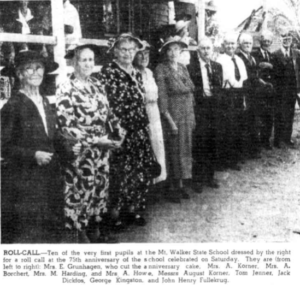 MOUNT WALKER LOWER (286-294 Mount Walker West Road)
MOUNT WALKER LOWER (286-294 Mount Walker West Road)
Mount Walker Lower Provisional School opened on 12th November 1923. Miss Yarwood from Dalby was the first teacher. The school work was carried on in a building leased from Mr. R. Tait, pending the erection of new premises. It closed 31st December 1967.
Mt Walker State Lower School opened 31st March 1928, on 3 acres land donated by Mr S. C. Franks. For the 4 years prior for the convenience of residents in the district has been conducted in an old disused house on one of the homesteads, but the attendance had increased to such an extent that a larger and more up to date building was imperative. Miss D. Madden was the teacher in charge. The school closed about 31st August 1945.
[Brisbane Courier, Thursday 23 February 1928, page 10]
Lower Mt Walker School – A new school house is bring erected at Lower Mt, Walker, where up to the present a deserted and antiquated dwelling has been doing service. The new building will be completed shortly, and the official opening is expected lo take place during March. Miss D. Madden is the teacher in charge, Mr, J. W. Schoenknecht and Mr. S. E. Franks are chairman and secretary respectively of the school committee.
[Queensland Times, Thursday 29 November 1923, page 6]
New School.-The residents of Lower Mt. Walker, who have been agitating for a school for. some considerable time, lave succeeded in their request, as a school has been opened in a building on the land owned at one time by Mr. M. Gough. This will be a decided advantage to a number of children who previously had to travel some considerable distance to school.
————————————————————————————
MERRYVALE
The school was originally held in an old building with slab walls and shingle roof that Mr. Murray had given the use of, part of an old hotel. The services of a private teacher (Mr. Richard Smith) were secured until a school was erected. The teacher was paid 6d. a week for older children and 3d. for small children.
Merryvale Provisional School opened 10th September 1894, with Miss Gibson as the first teacher. In October 1896 tenders were called for the erection of a new Provisional School building at Merryvale to replace the old one. Miss Gibson succeeded by Miss Duncan, and later by Mr. Kelly. Mr Keely became ill and unable to carry on his duties and some time elapsed before a successor was appointed. During this period a number of the children attended other schools, resulting in the Merryvale school being closed 23rd September 1904 and removed to Franklyn Vale, opening on 5th March 1906 as Franklyn Vale Provisional School. It remained there for some time until it closed in 1915 because of low attendance.
It was once again relocated back to Merryvale in 1922. On 15th May it reopened as Merryvale State School with Miss R. E. Pedrazzini appointed as head teacher. The occasion was celebrated with a picnic and sports day on Saturday 10th June. The catering was done by Mrs J. Evers from Rosewood. The members of the committee present during the day: were Messrs. J. W. Ahearn (chairman), E. C. Cutler (secretary), D. O’Brien (treasurer), W. Lund, J. Murray, A. Fullekrug and A. Stubbs.
The school closed in 1950 and subsequently reopened. It closed permanently 16th June 1961, due to low attendance.
[Queensland Times, Wednesday 28 November 1951, page 10]
SCHOOL PICNIC ON NEW SITE. MT. WALKER, Nov. 27.The Merryvale School picnic held on Saturday was the first conducted since the building was removed to its new site. The school previously was situated on the Mt. Walker-Mt. Mort Road. and its present position on the Mt. Walker West-road is about two miles from its old location. The building was moved for the convenience of a number of children who lived on the western side of the river, and who previously attended the Mt. Walker school. During the wet seasons those children lost a deal of schooling when the river was in flood, and the present situation of the Merryvale school is much more convenient to them. After being closed for a short period, the school was reopened following the August vacation, Mr. C. Leach being appointed teacher.
The picnic committee, consisting of Messrs. J. W. Ahearn (Chairman), P J. Ahearn (Secretary), L. Schmidt (Treasurer), R. Rackley, G. Rackley. M. Ahearn, and W. Davis, ably assisted by their wives, and the Headteacher (Mr. Leach) did much to make the function a success. Luncheon and afternoon tea were served and the children were given ice creams, fruits. soft drinks, and lollies.
SPORTS PROGRAMME In the afternoon a sports programme for the children was carried out, and competitions were held for the adults. Mr. A. G. Muller. M.L.A.. and Mrs. Muller were present as guests of the committee. During the afternoon Mr. Muller addressed the gathering.
Other guests of the committee were: Mr. J. M. Bowles (Headteacher of the Mt. Walker School) and Mrs. Bowles, Mr. W. Melville (Headteacher of the Rosevale School) and Mrs. Melville.
At night a dance held in the Rosevale Hall was well attended. Music was supplied by the “Three G’s” Orchestra, and the duties of M.C. were carried out by Messrs. R Rackley and W. Melville. A novelty Waltz was won by Miss E. Nugent and Mr. Melville, and a competition for a trophy was won by Mrs. P. Kelly.
————————————————————————————
ROSEVALE (43 Tierneys Bridge Rd, Rosevale)
Rosevale Primary School opened 24th November 1884 . Thirty-eight children attended the first year. Mr W. H. Willey was the first teacher in a one roomed school building. In 1934 at the golden jubilee celebrations most of the 26 surviving original pupils were there.
Situated on one of the foothills of the Little Liverpool Range, overlooking the rich plain of the head waters of the Bremer River, the site of the school is picturesquely flanked by that historic section of the Great Dividing Range which includes Cordeaux, Mitchell and Spicer peaks, and Cunningham’s and Spicer’s gaps.
The school was mothballed on 31st December 2009 and closed on 31st December 2010, after 126 years.
————————————————————————————
MOORANG (Southern side of Logan Lane)
29/01/1894 – 13/12/1920
On 1st January 1909 it became Moorang State School. It closed in 1913 but re-opened in 1914 before permanently closing in 1920. All buildings were removed from the site and in December 1985.
Few of your readers have ever heard of “Moorang.” It is the name given to the provisional school now erected on the stretch of country mid-way between Boyds Creek and the Bremer. The Education Departrent requested the secretary of the school (Mr. J. Reddy) to give it a distinctive name other than “Rosevale,” and he very appropriately gave it an aboriginal appellation (meaning duck). Mr. J. English gave two acres of land on which the school stands, and the secretary, in sending in his plan to the departnment, seems to have gone in for centrality of position, for a more suitable site could not be availed of. The school, which is the best provisional one I have ever seen in my travels, is 22ft. by 16ft., with a 6ft. verandah, and is composed of sawn hardwood. Mr. Jerry Wooldridge is the contractor, and he building and furniture reflect great credit on him for the workman-like manner in which they are executed. The total cost of buildling will exceed £90, and the committee will have a debit balance of about £25, which it is hoped will soon be wiped off. Of course the usual petty jealousies were indulged in, with reference to site, transfer, &c., but “All’s well that ends well.” The parents have to be thankful to the committee for their perseverance and unflagging energy in supplying a long-felt want.
[Queensland Times, Ipswich Herald and General Advertiser, Tuesday 18 April 1893, page 2]
The completion of the provisional sohool was celebrated, on Friday night, by concert and dance, and as the school is situated “seven miles from everwhere” the “muster”-over twenty couples-was exceedingly good. The night was a most enjoyable one. Messrs Le Praik, Tierney, Tait, Noonan, and others favoured the company with some well rendered songs which were heartily received. Mr. Le Praik made a most efficient M.C, while Messrs. W. Tierney (violin) and M. Enright (concertina) provided the music. Mr. Dan. Carroll’s pas de seul was a feature of the evening. Dan’s heroic effort to make up very slight deficiency of ladies by dressing and acting as one was highly commendable, and, except that he nearly frightened Mrs. Reddy’s baby into fits, was most successful. At midnight, tea and sandwiches, under Mrs. John Reddy’s supervision, filled many an aching void. More music and dancing followed, and daylight just caught the remnants of a tired but merry party homeward bound. The function reflected great credit on the members of the school committee present: Messrs. Reddy, O’Hanlon and English. The school building itself is certainly the best of its kind–i.e, provisional school-I have seen, and except for coat or two of paint is quite equal to the average State school. True, the school has been three years-to put it mildly-in hand, but that it is now finished is almost entirely due to the energy, and determination displayed by Mr. John Reddy and great credit is his for that same. Mr. James English gave the site on which the school stands, and Mr. John O’Hanlon, though he is not a resident now, has rendered yeoman service monetarily and otherwise. Miss Murphy, the teacher, opens the school forthwith, and we all hope to see the school well filled and flourishing. [Queensland Times, Ipswich Herald and General Advertiser (Qld. : 1861 – 1908), Tuesday 30 January 1894, page 3]
Moorang Provisional School.
We have been requested to publish the following report of the inspection of the Moorang provisional school, of which Miss Elizabeth J. Murphy is the head teacher, and which was inspected by Mr. District Inspector Kennedy on the 28th October:-
“Material Organisation.-Accommodation is sufficient in amount and good in kind. The furniture, &c., are nearly sufficient in amount, very good in kind, and in an excellent state of repair. The premises are very tidy and very clean, and the school property is very well taken care of. The disposal of material for instruction is very neat and careful. The neatness and cleanliness of the school-room and all the surroundings are noted with much satisfaction.
Records are very well kept. The records of attendance are neat, complete, and, with one extremely slight exception, accurate; other records are very satisfactory, but for a few omissions in the Corporal Register.
Attendance.-The average attendance is 81.3 per cent, of the enrolment for last month. Number of pupils who attended four days out of five during last quarter is 35.3 per cent. of the enrolment for that quarter. The attendance is therefore good in quantity, and indifferent to very indifferent in quality. The punctuality is excellent. Number on roll, 82; average attendance for last month, 26.
Government.-The character of the discipline is very good. The moral tone appears to be good. The school habits are quite satisfactory, and the general behaviour is satisfactory. Class movements are very fairly done, and good order is maintained.
Routine.-The time-tables are suitable. The school is worked in a very energetic and painstaking manner. The classification is very good.
Methods.-The methods employed in teaching are generally commendable. They are applied with very fair skill and praiseworthy energy.
Proficiency.-Quantity of work attempted is very satisfactory; average proficiency is above fair.
Progress.-Good. General condition of the school is very creditable.
Remarks.-Notwithstanding very irregular attendance during the past quarter, the pupils show creditable proficiency, and the work, as a whole, is rendered in a way that speaks highly for the ability and diligence with which the school is conducted. There is room for improvement in the quality of reading and recitation. Mental arithmetic still needs careful attention. Mapping is rather poor, and the grammar of class IV. requires attention.” [Queensland Times, Ipswich Herald and General Advertiser, Tuesday 10 December 1895, page 6]
THE MOORANG PROVISIONAL SCHOOL
To the Editor of the Queensland Times
Many at your readers will, no doubt, have observed with pleasure that the Moorang Provisional School was successful in securing five first and three second prizes for copy-books, exercises and needlework respectively at the recent Rosewood Show, notwithstanding the fact that a number of State schools had to be competed against. This must be very gratifying to the successful pupils and heir teacher, especially when they had to battle against such a number of competitors. I may sate that this is the third occasion on which the above school has been successful in securing prizes. Yours &c., C.A.B.
[Queensland Times, Ipswich Herald and General Advertiser (Qld. : 1861 – 1908), Saturday 18 September 1897, page 7]
In May 1898, the building of the school-residence at Moorang was to begin shortly, the accepted tender for the work being that of Mr. Jens Nielson.
© Jane Schy, 2024
Published 07/02/2024
